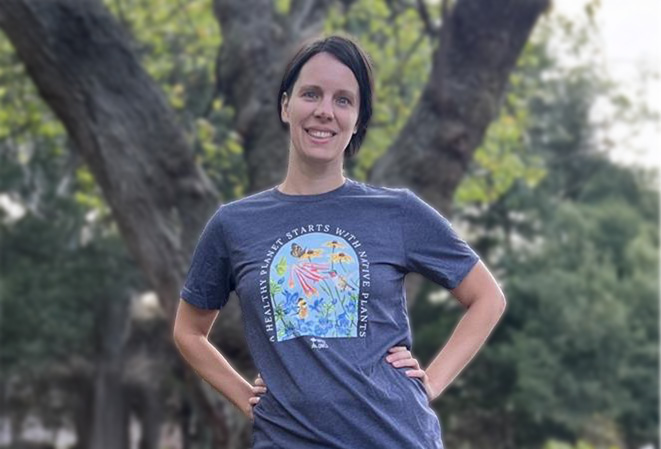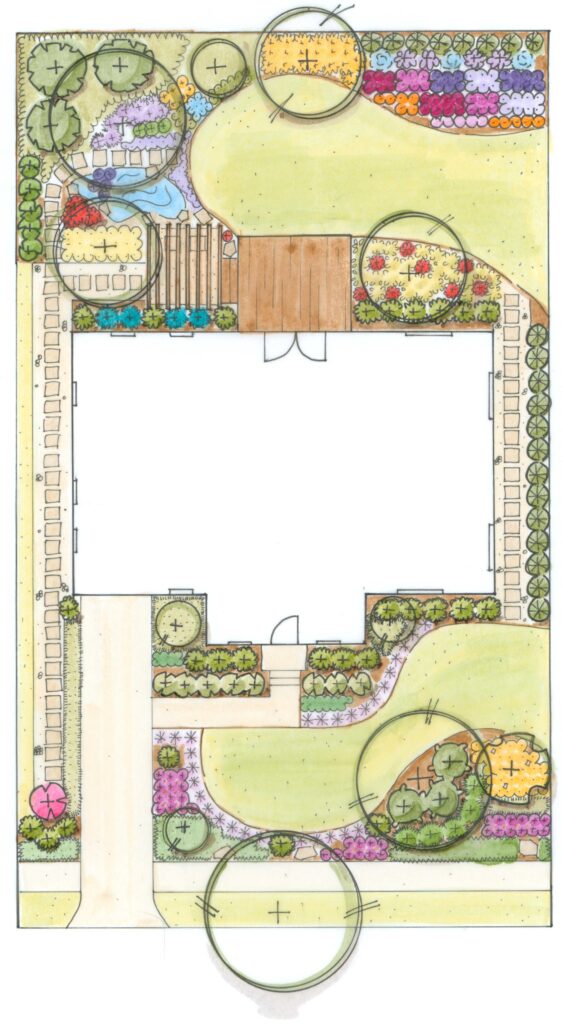
Printing note: This design was created to be 8.5″ x 14″, and the design PDF will print best on legal-size paper.
Part of the Wild Ones Native Garden Design series, this garden plan was created by EARTHeim Landscape Design in Lexington, Kentucky, and can be applied to the surrounding Interior Plateau ecoregion (8.3.3). The design helps homeowners replace traditional lawn with native plantings that thrive in the region’s alkaline soils, humid subtropical climate, and patchwork of sun and shade conditions.
This regionally tailored plan was created to support biodiversity, improve resilience to flooding and drought, and create a layered habitat for pollinators, birds, and other wildlife while offering a practical, beautiful alternative to conventional landscaping.
Designer Statement
“Remagic your piece of earth” is something that we can do on our property by planting native plants and designing our yards to encourage sustainability. We should not think the landscaping around our home should be something static that should remain the same and only be there to accent our homes. The structure inside our homes may be mostly static and something only we have influenced. The outside, however, is home to an ever-changing landscape with weather, insects, animals, and microorganisms, which we have very little control over. While we want to reduce landscape maintenance so it’s practical for us to have, we must realize that a living landscape should benefit the environment and wildlife.
Site Conditions
Central Kentucky is now in USDA plant hardiness zone 7a. Our soils typically have a higher pH than Eastern Kentucky, for example, because we have limestone in our area. Many of the natural areas in our city are overrun with invasive species such as Japanese bush honeysuckle (Lonicera japonica), wintercreeper (Euonymus fortunei), privet (Ligustrum spp.), and Bradford pears (Pyrus calleryana). Our region has also felt the effects of climate change with an increase in flooding, ice storms, long, hot summers, dry weather, and extreme weather events. Many people want to start using native plants because they will be hardier in our climate.
At the site, I assess and take measurements of the landscape for existing locations of all features such as buildings, hardscapes, utilities, and trees. In this Lexington property, there is a mix of deep shade, part shade, and full sun areas. The north side of the home and the area under the redbud tree are some of the shadiest spots, while the northeastern corner of the backyard is a sunny area ideal for pollinator plantings.
In Central Kentucky, we have clay soils that are more alkaline due to the presence of limestone. Especially in newer construction, where the topsoil is often removed, I recommend adding a layer of compost to the garden beds immediately after planting, and then once a year in the fall.
When I design, I also look at sunlight patterns, soil conditions, and drainage. I consider areas that may collect more rainwater or where drainage from structures will be diverted. If a plant likes moist soils, then I’ll use it in those wetter areas. This particular property includes areas that would be prone to summer drought and others with heavier spring moisture.
Design Approach
I begin by laying out hardscape features, then work on dividing the area into planting zones based on the microclimate of each space. I’m always thinking about how to design each zone to be both aesthetically pleasing and ecologically functional.
My goal is to put the right plant in the right place and to space them properly according to their mature size to reduce the need for pruning. Another goal is to cover the ground with a “living mulch” as much as possible with plants, which helps reduce the need for hardwood mulching and suppresses weeds naturally. I also consider the watering needs for the different species. A native plant garden can survive drought, but it will look better with some consistent water—especially in our hot Kentucky summers.
I strive to educate my clients by sharing interesting facts about the plants as I collaborate with them throughout the design process. I think this makes the design more memorable, especially considering how the native plants provide ecosystem services.
Phasing
1. Hardscape
The first step to this garden’s installation would be to install the hardscape features before any plantings surrounding the hardscape are installed to prevent damage to the plants. Individual garden beds can be installed one at a time until the full landscape is complete.
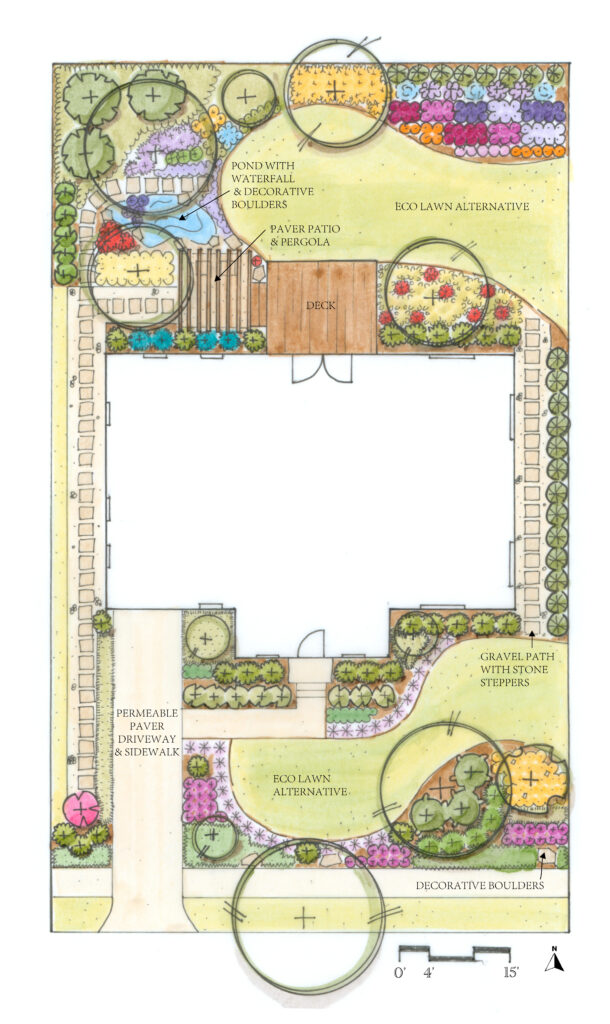
2. Structure and Beds
Trees and Shrubs
Install trees and shrubs first, as they require more time to mature and will make a significant impact. I urge clients to install garden beds in full rather than small sections across the entire property, as this will not achieve as much impact, and it will require a lot of maintenance until the plants fully cover the ground.
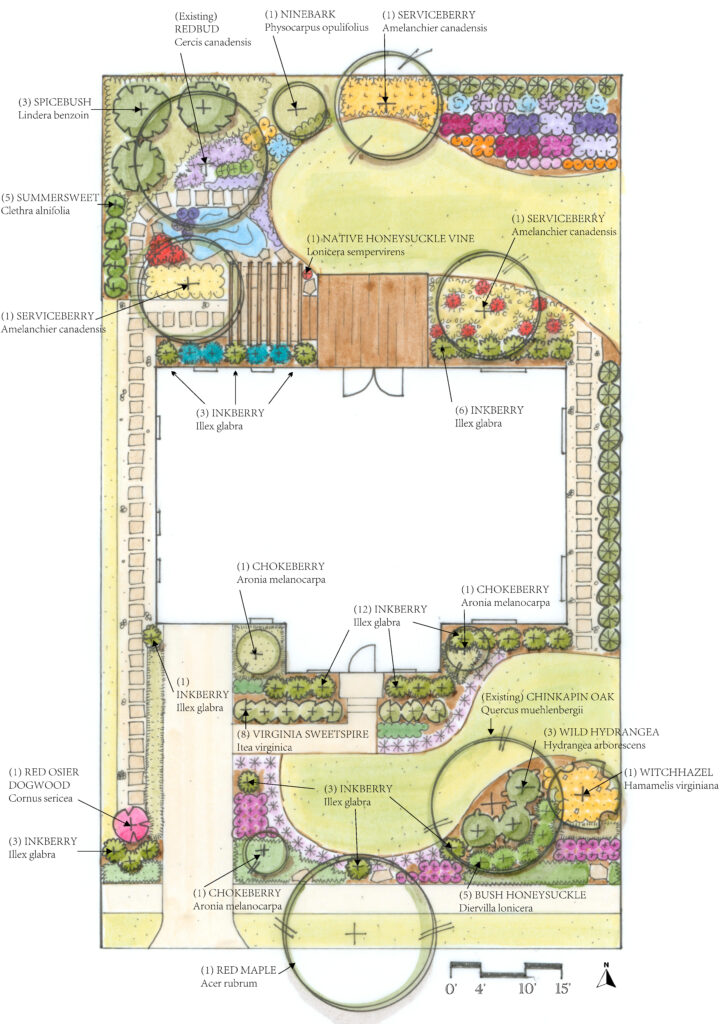
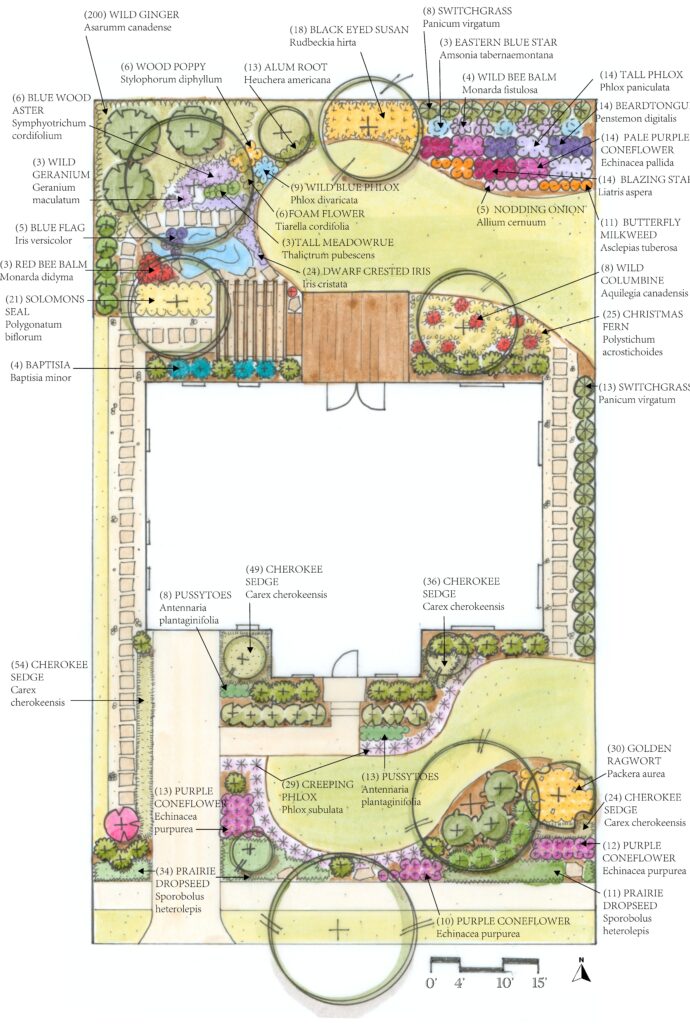
Groundcover Plants
If needed, groundcover plants such as sedges (Carex spp.), wild ginger (Asarum canadense), Solomon’s seal (Polygonatum biflorum), black-eyed Susan (Rudbeckia hirta), dwarf crested iris (Iris cristata), and golden ragwort (Packera aurea) can be installed in smaller numbers and allowed to spread on their own. Some companies also sell plants as ‘plugs,’ which are sold in larger quantities in trays for a lesser cost than larger plants.
3. Soil and Lawn Prep
Amending Soil
In Central Kentucky, we have clay soils that are more alkaline due to the presence of limestone in our region. Especially in newer construction, where the topsoil is often removed, I recommend to my clients that a layer of compost be added to the garden beds immediately after planting, and then once a year in the fall. Some plants, such as the inkberry holly (Ilex glabra), will benefit from an organic fertilizer specifically designed for plants that prefer acidic soil, as our soils tend to be more alkaline.
Lawn Removal
Existing lawn can be removed in several ways, either by manual removal with a sharp flat spade or a sod cutter machine. The sheet mulching or solarization methods can also be used, but this process is longer. Tilling should be avoided as this can damage soil and hurt native bees that nest in the ground.
Eco-lawn Alternative
There are eco-lawn seed alternatives available on the market if you are looking to replace traditional turfgrass with a lawn that requires less maintenance. When researching seed blends, homeowners should consider which seed blend is most suitable for their specific microclimate. Many seed blends are designed for sunnier sites rather than shade. Some seed blends require mowing only once or twice a year.
Native sedges (Carex spp.) may also be considered a lawn alternative, which would not require mowing. There is also a trend of creating a clover lawn (although non-native) or using buffalograss (Bouteloua dactyloides), a native North American species. When spreading seed, it is essential to maintain seed-to-soil contact and keep the area watered to ensure adequate germination.
4. Planting Timeline
Perennials can be planted in the spring, as long as any threat of frost or freeze has passed, which typically occurs around mid-May. Spring in Kentucky is often unpredictable. Perennials can be planted earlier if the weather warms, but this is a risk due to late frosts and freezes. The latest time to plant perennials in Kentucky is mid-September. This allows roots to mature and harden before freezing winter temperatures settle in for the next few months.
Generally, spring-blooming trees and slow-growing hardwood trees should be planted in early spring. Faster-growing trees can be planted in spring or early fall. Trees and large shrubs planted in the heat of the summer can have a hard time establishing and will suffer transplant shock.
A Native Garden’s Ecosystem Services
This design’s key elements, aimed at addressing climate change and providing ecosystem services, include:
- Reducing lawn to minimize water use, carbon emissions/resources for mowing, and chemical usage.
- Increasing shade by planting trees to lower surrounding temperatures in the summer months.
- Plantings that will sequester carbon dioxide, produce oxygen and capture/filter stormwater runoff.
- Providing habitat and food sources for wildlife and pollinators.
- Using permeable materials for the driveway and hardscape allows water to filter through, rather than contributing to stormwater runoff.
Design Considerations and Key Features
Front Yard
In this design, I wanted to create an aesthetic front yard for curb appeal and ease of care while still being unique. Often, my clients want the front yard to appear tidier since it’s viewable from the street. I began by locating evergreen inkberry holly (Ilex glabra) shrubs along the foundation and as anchor points in the garden beds to offer some winter interest.
I used a repetition of purple coneflower (Echinacea purpurea), sedges (Carex spp.), and grasses across the different garden beds to create a cohesive and peaceful feeling. Most plants in the front yard are shrubs and groundcover types, with some Echinacea to offer some summer color. Some of the groundcover plants will stay green during the winter as well. Sedges and grasses offer a soft texture to the landscape and will create movement in the garden on a breezy day.
Witch hazel (Hamamelis virginiana) is a late-fall-blooming shrub and one of the only blooming plants in November and December. Even in these cold months, I will see small native bees pollinating the yellow flowers of this native shrub. After flowering, squirrels will come and feed on the seeds.

Front Yard Shrubs:
- Witch hazel (Hamamelis virginiana)
- Chokeberry (Aronia melanocarpa)
- Inkberry holly (Ilex glabra)
- Wild hydrangea (Hydrangea arborescens)
- Virginia sweetspire (Itea virginica)
- Bush honeysuckle (Diervilla lonicera)
- Red osier dogwood (Cornus sericea)
Groundcover Type Plants:
- Creeping phlox (Phlox subulata)
- Sedge (Carex cherokeensis)
- Prairie dropseed (Sporobolus heterolepis)
- Pussytoes (Antennaria plantaginifolia)
Bird Habitat
At the southeast corner of the front yard is a shrubby corner that creates a small wildlife habitat for birds under the large shady oak tree. Birds prefer to roost in natural areas with layers. Here, we have the oak as a canopy tree, followed by a layer of large and small shrubs, perennial plants, and ground cover. The chokeberry shrubs, purple coneflower, prairie dropseed, and sedge groundcover offer berries and seeds for birds to forage on.

Side Yards
I designed a gravel pathway with inset stepping stones at the side yards. When we install designs, we like to use gravel that will compact so it is sturdier underfoot. Depending on the color of the home, the gravel and stone can be of a cool or warm tone. On the east side of the home, the walkway is lined with switchgrass (Panicum virgatum) to offer a soft texture along this property line. On the west side of the home, the walkway begins along the driveway to expand its functionality by offering additional space for getting in and out of the car.
Backyard
In the backyard, I wanted more relaxed plantings that were viewable from the deck and an additional hardscaped patio with a pergola. A native honeysuckle vine (Lonicera sempervirens) can be grown on the pergola, which will attract hummingbirds.
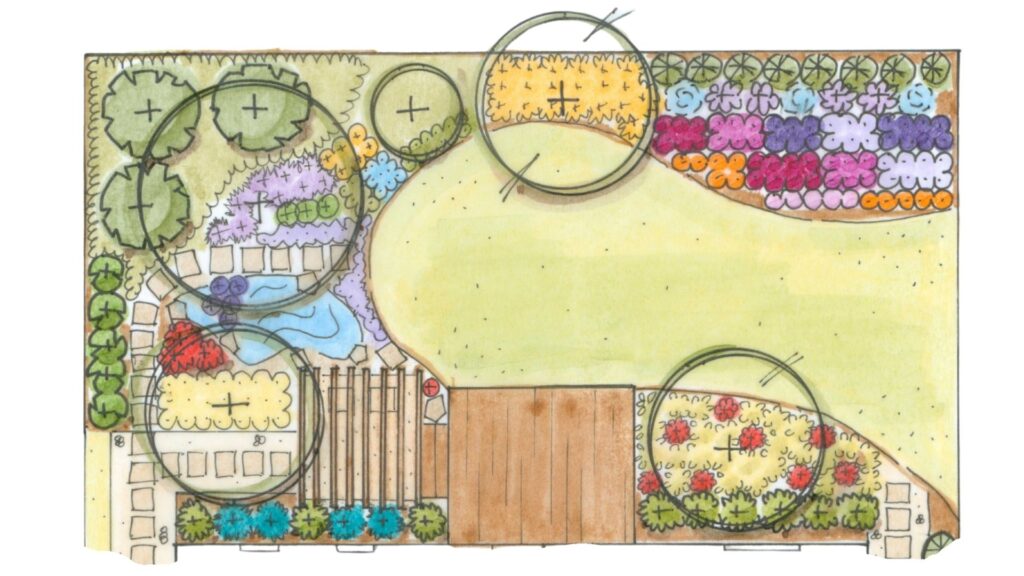
Pond and Backyard Northwest Shade Garden
Off the patio is a small pond with a circulating waterfall feature. This will support birds that are looking for a water source and could also attract frogs, dragonflies, and other wildlife. Native blue flag iris (Iris versicolor) can be planted in pots and set into the pond. A pathway wraps around the pond for viewing access from all sides.

A pond kit with liners and pumps can be purchased from retailers specializing in pond construction. Different sizes of boulders, cobblers, and gravel can be ordered from local landscape suppliers to hold the liner in place and decorate the pond. Here in zone 7a, ponds can generally be operated all year unless we have below-normal winter weather conditions. This provides a much-needed habitat for birds in the winter.
Under the existing redbud tree (Cercis canadensis) and around the pond is a small shade garden. In this shade garden, we have used layering with a redbud understory tree, spicebush (Lindera benzoin) shrubs, and wild ginger (Asarum canadense) as a groundcover. This layering effect creates more habitat that will attract more birds to this area of the yard. There are several species of native plants that will bloom from spring and into fall. Blue wood aster (Symphyotrichum cordifolium) is a fall-blooming shade-tolerant aster with beautiful blue flowers. Wild blue phlox (Phlox divaricata) is a blue spring bloomer that adds a soft fragrance to the air.
Sunny Northeast Pollinator Garden
In the northeastern part of the yard, a colorful pollinator garden features native plants that bloom during the summer months. This sunny area in the backyard will attract butterflies and bees. There is a layering effect to this garden. The back border of switchgrass adds a soft background. The next layer of plants is taller, full of bushier native plants like wild bee balm (Monarda fistulosa) and amsonia (Amsonia tabernaemontana), and other tall prairie plants: purple coneflower (Echinacea purpurea), tall garden phlox (Phlox paniculata), beardtongue (Penstemon digitalis), and blazing star (Liatris spicata). The front border is shorter, featuring butterfly milkweed (Asclepias tuberosa) and nodding onion (Allium cernuum). Many of these plants will reseed themselves in the garden if given the right environment.

North Shade Garden
The north side of the home, against the back of the house, will be one of the shadiest areas on the property. Under the serviceberry tree (Amelanchier canadensis), east of the deck, is a Christmas fern (Polystichum acrostichoides) garden with wild columbine (Aquilegia canadensis) scattered throughout that will offer some color in the spring and attract hummingbirds. The Christmas fern will remain evergreen throughout the winter, providing seasonal interest.

Maintenance and Supporting Habitat
Leaving the Leaves
Fallen leaves are a valuable source of organic matter for the garden. Adding them to garden beds or mulch rings provides hibernation sites for pollinators and other beneficial insects, such as ladybugs and lightning bugs, throughout the winter.
Spring Garden Cleanup
Leaving plants standing through the winter also provides habitat and food sources for birds, pollinators, and wildlife. Cutting back this foliage in late spring allows beneficial insects to hatch and emerge from their nests. Cutting and disposing of the brown plant material too early can also dispose of the pollinators and beneficial insects. This brown matter also acts as insulation, helping plants overwinter.
Mulching & Living Mulches
Reducing mulching needs is one way to reduce overall maintenance in a garden. Bare soil and mulched areas invite weeds and invasive species. Use groundcovers that will fill in areas underneath shrubs and between feature plants. This can include plants that spread by root or seed. Create a groundcover planting plan by choosing plants with a similar competitive ranking of low, medium, or high spread rate.
Watering
I tell my clients that the garden should receive an inch of water per week, whether from rainfall or manual watering. Plants with higher watering requirements should receive consistent hydration. A native plant garden can survive drought, but it will look better with consistent water. It is essential for evergreen plants to stay hydrated in late summer and fall to ensure a better survival rate through winter and reduce their susceptibility to browning. Drip irrigation can be installed to assist homeowners and is particularly useful when establishing plants or during periods of minimal rainfall.
Plant List
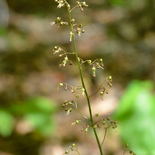
Alum Root(Heuchera americana)
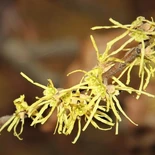
American Witchhazel(Hamamelis virginiana)
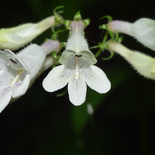
Beardtongue(Penstemon digitalis)
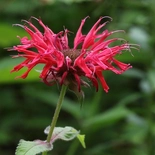
Bee Balm(Monarda didyma)
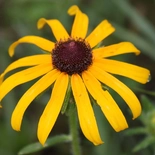
Black Eyed Susan(Rudbeckia hirta)
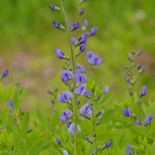
Blue False Indigo(Baptisia australis var. minor)
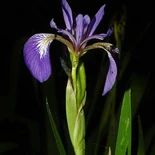
Blue Flag(Iris versicolor)
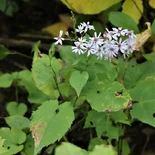
Blue Wood Aster(Symphyotrichum cordifolium)
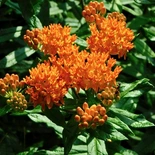
Butterfly Milkweed(Asclepias tuberosa)
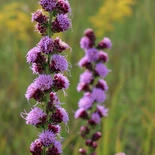
Button Blazing Star(Liatris aspera)
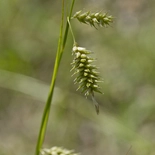
Cherokee sedge(Carex cherokeensis)
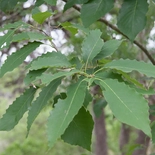
Chinkapin Oak(Quercus muehlenbergii)
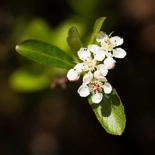
Chokeberry(Aronia melanocarpa)
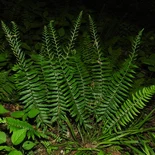
Christmas Fern(Polystichum acrostichoides)
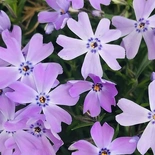
Creeping Phlox(Phlox subulata)
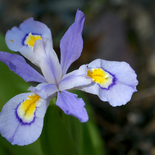
Dwarf Crested Iris(Iris cristata)

Eastern Blue Star(Amsonia tabernaemontana)
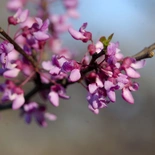
Eastern Redbud(Cercis canadensis)
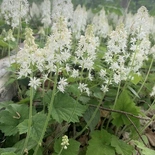
Foamflower(Tiarella cordifolia)
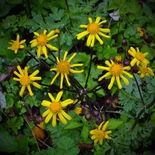
Golden Ragwort(Packera aurea)
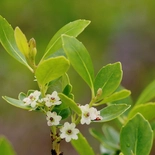
Inkberry Holly(Ilex glabra)
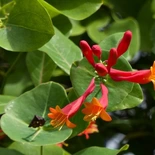
Native Honeysuckle Vine(Lonicera sempervirens)

Ninebark(Physocarpus opulifolius)
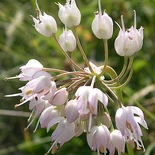
Nodding Onion(Allium cernuum)
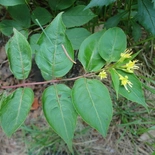
Northern Bush Honeysuckle(Diervilla lonicera)
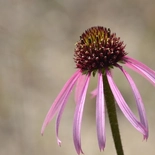
Pale Purple Coneflower(Echinacea pallida)
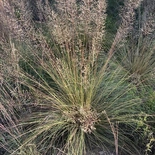
Prairie Dropseed(Sporobolus heterolepis)
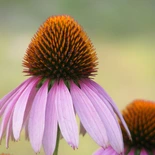
Purple Coneflower(Echinacea purpurea)
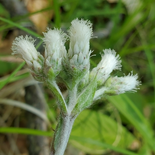
Pussytoes(Antennaria parlinii)
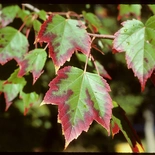
Red Maple(Acer rubrum)
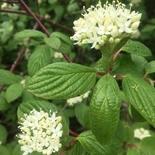
Red Osier Dogwood(Cornus sericea)
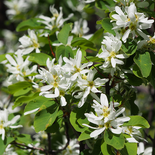
Serviceberry(Amelanchier canadensis)
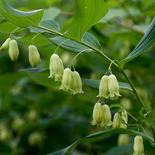
Solomon's Seal(Polygonatum biflorum)
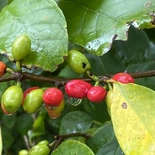
Spicebush(Lindera benzoin)
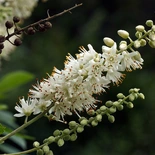
Summersweet(Clethra alnifolia)
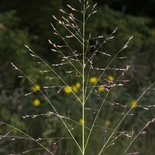
Switchgrass(Panicum virgatum)
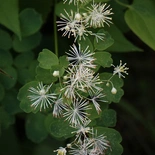
Tall Meadowrue(Thalictrum pubescens)
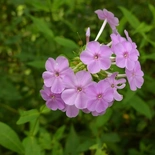
Tall Phlox(Phlox paniculata)
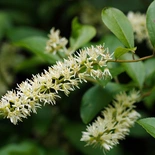
Virginia Sweetspire(Itea virginica)
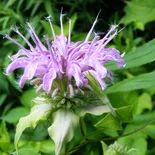
Wild Bee Balm(Monarda fistulosa)
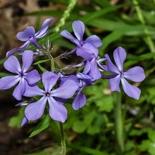
Wild Blue Phlox(Phlox divaricata)
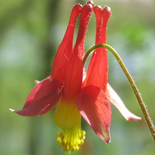
Wild Columbine(Aquilegia canadensis)
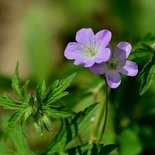
Wild Geranium(Geranium maculatum)
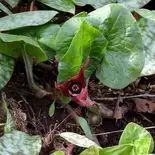
Wild Ginger(Asarum canadense)
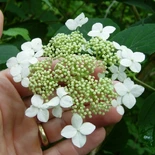
Wild Hydrangea(Hydrangea arborescens)
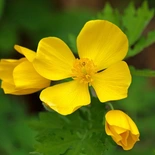
Wood Poppy(Stylophorum diphyllum)
About the Designer
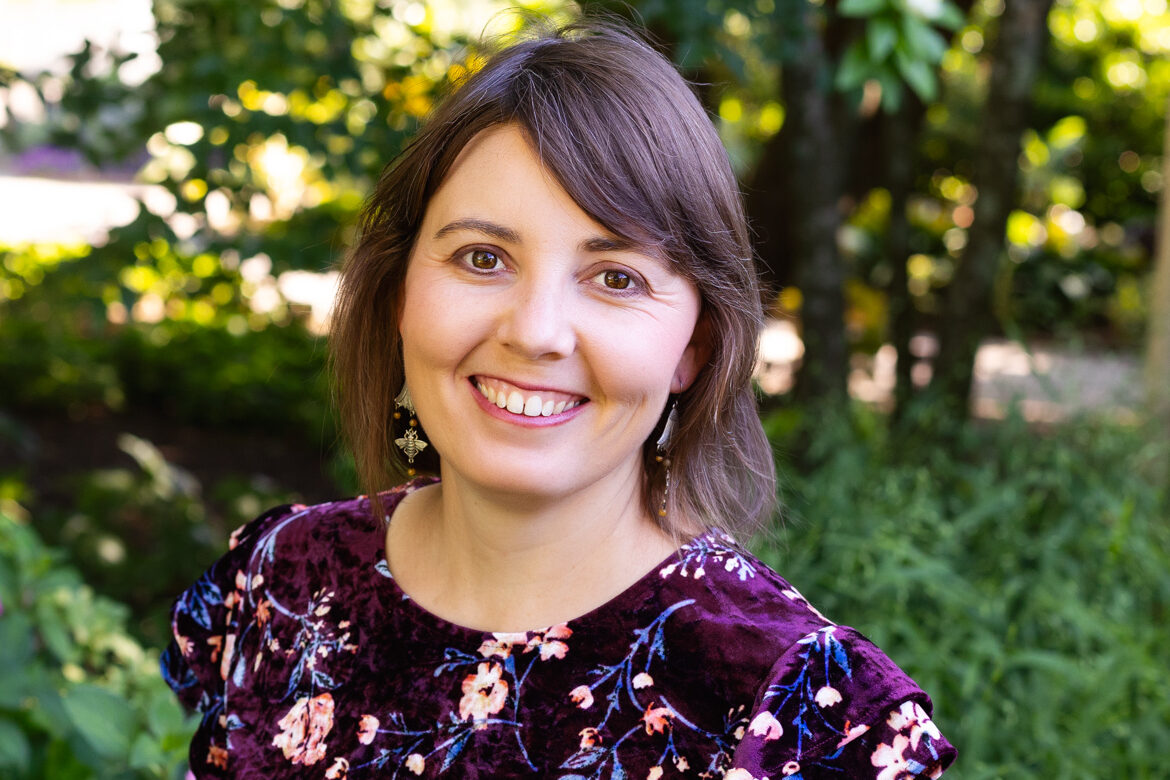
Katrina Kelly is a landscape designer with a passion for native plants and using them in urban and suburban landscapes. She is the owner and designer of EARTHeim Landscape Design, LLC in Lexington, Kentucky. Some notable projects include a courtyard design for the Sisters of Loretto Motherhouse, the city of Berea KY, and Plant By Numbers program with the city of Lexington. She served on the board for Wild Ones Lexington Chapter from 2017-2023. She is a Kentucky Certified Nurseryman, Certified Pollinator Steward, and a Certified Backyard Wildlife Master Gardener. Katrina graduated from the University of Kentucky with BS and BA degrees in Landscape Architecture and Music respectively.
Katrina began her native plant journey at the Salato Wildlife Center in Frankfort, Kentucky, working at the native plant greenhouses. During college, she worked at The Arboretum, State Botanical Garden of Kentucky. Upon graduation, she founded her own company in 2013, driven by the need for more native plant design. She enjoys teaching others about native plants and sustainable gardening techniques.
About Wild Ones
Wild Ones (a 501(c)(3) nonprofit organization) is a knowledgeable, hands-on, and supportive community focused on native plants and the ecosystem that depends on them. We provide resources and online learning opportunities with respected experts like Wild Ones Honorary Directors Doug Tallamy, Neil Diboll, and Larry Weaner, publishing an award-winning journal, and awarding Lorrie Otto Seeds for Education Program grants to engage youth in caring for native gardens.
Wild Ones depends on membership dues, donations and gifts from individuals like you to carry out our mission of connecting people and native plants for a healthy planet.
Looking for more native gardening inspiration? Take a peek at what our members are growing!

